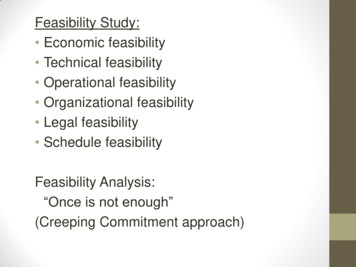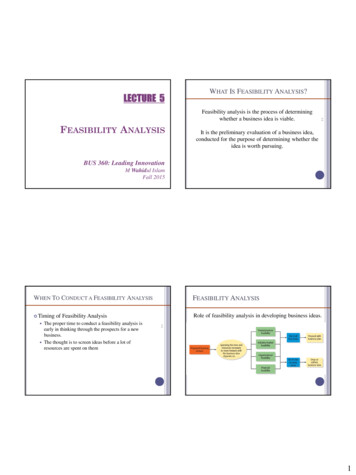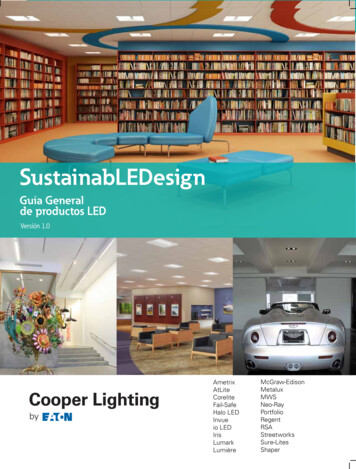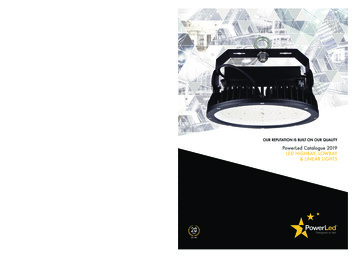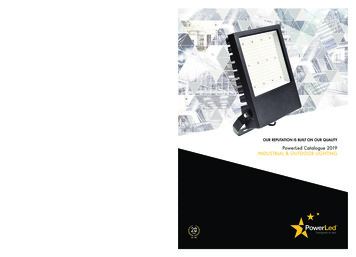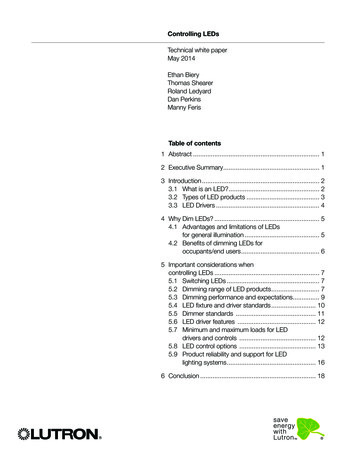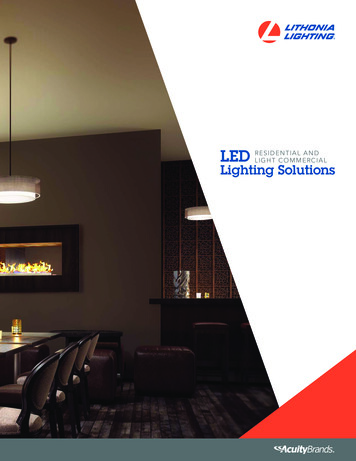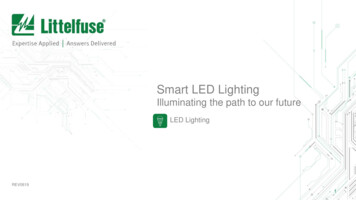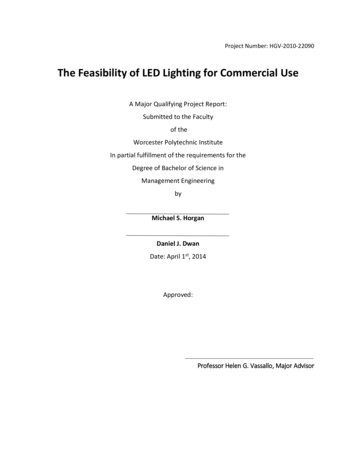
Transcription
Project Number: HGV-2010-22090The Feasibility of LED Lighting for Commercial UseA Major Qualifying Project Report:Submitted to the Facultyof theWorcester Polytechnic InstituteIn partial fulfillment of the requirements for theDegree of Bachelor of Science inManagement EngineeringbyMichael S. HorganDaniel J. DwanDate: April 1st, 2014Approved:Professor Helen G. Vassallo, Major Advisor
Table of ContentsTable of Figures . 2List of Tables . 3Abstract . 4Executive Summary. 41.0 Introduction and Problem Statement . 52.0 Materials and Methods . 62.1 Literature Review . 62.2 Market Analysis . 62.3 Cost/Benefit Analysis . 62.4 Behavioral Analysis . 73.0 Results . 73.1 Market Analysis . 73.1.1 Market Size and Segmentation . 73.1.2 Competition . 93.1.3 Growth and Recent Market Trends . 93.1.4 SWOT Analysis. 113.2 Cost Benefit Analysis - LED vs. Incandescent, CFL, Linear Fluorescent . 123.2.1 Incandescent Light Bulbs . 123.2.2 Compact Fluorescent Bulbs . 143.2.3 LED Light Bulbs . 153.2.4 Linear Tube Lighting – Fluorescent vs. LED . 153.3 Cost-Benefit Analysis – Phi Gamma Delta Fraternity House. 163.4 Survey Results . 174.0 Discussion. 204.1 Literature Review . 204.1.1 Brief History of Lighting . 204.1.2 Mechanisms of Incandescent Lighting . 214.1.3 Mechanisms of Fluorescent Lights. 224.1.4 Mechanisms of LED Lights. 224.1.5 Current Trends in the lighting and LED market . 244.2 Market Analysis . 264.3 Cost Benefit Analysis: LED vs. Incandescent, CFL, Linear Fluorescent . 261
4.3.1 Standard Bulb Comparison: Incandescent, CFL, LED . 274.3.2 Tube Lighting Comparison – T8 Linear Fluorescent, T8 Linear LED . 284.4 Cost Benefit Analysis - Phi Gamma Delta Fraternity House. 284.5 Survey Discussion Table . 325.0 Conclusions and Recommendations . 335.1 Conclusions . 335.2 Recommendations . 356.0 References . 367.0 Appendix . 387.1 Survey Appendices . 387.1.1 Distributed survey and number of responses . 387.1.2 Survey Results . 387.1.3 Graphs of Survey Questions . 417.2 Cost Benefit Analysis Appendices . 457.2.1 Energy Audit . 457.2.2 Floor Plan of Phi Gamma Delta . 457.3 Project Contributions . 47Table of FiguresFigure 1 Annual Electricity Consumption by Sector and Type of bulb. 8Figure 2 World Market for Lamps by Technology . 10Figure 3 Forecasted Retail price for all Replacement LED lamps. 11Figure 4 SWOT analysis of LED lighting . 11Figure 5 . Breakdown of Incandescent Bulb19 . 21Figure 6 Breakdown of Fluorescent bulb21 . 22Figure 7 Composition of LED Semiconductor22 . 22Figure 8 Sketch of output for typical laser diode as a function of drive current for three separate temps.22. 23Figure 9 Sketch of Semiconductor laser light22 . 23Figure 10. Breakdown of components in a LED light bulb . 24Figure 11 Newly Enforced Government Standards for Incandescent Lightin30 . 25Figure 12 Advancements of different lighting technologies . 25Figure 13 Survey taken by Respondents . 38Figure 14 Survey Results with Statistical Analysis . 39Figure 15 Pie Chart of answers from Survey Question 1 . 41Figure 16 Pie Chart of answers from Survey Question 2 . 42Figure 17 Pie Chart of answers from Survey Question 3 . 422
Figure 18 Pie Chart of answers from Survey Question 4 . 43Figure 19 Pie Chart of answers from Survey Question 5 . 43Figure 20 Pie Chart of answers from Survey Question 6 . 44Figure 21 Average of Answers from Survey Question 7 and the variance of answers . 44Figure 22 Basic Floor plan of Basement . 45Figure 23 Basic Floor plan of the first floor. 46Figure 24 Basic Floor plan of the second floor. 46Figure 25 Basic Floor plan of the third floor . 47List of TablesTable 1 Summary of Energy Audit. 16Table 2 LED Lights replacing traditional light forms . 17Table 3 Survey Results . 19Table 4 Cost of LED Lighting . 28Table 5 Replacement costs of LED light bulbs . 29Table 6 Total annual cost of bulbs . 30Table 7 Potential Cost Savings of LED bulbs . 30Table 8 Survey Discussion Table . 32Table 9 Table of the energy audit raw data used to perform calculations . 453
AbstractRecent developments in light-emitting diode technology have allowed LED lighting products topenetrate the commercial lighting market with enormous potential for growth. Our team developedseveral conclusions forecasting the future of LED lighting in the commercial market and maderecommendations for a business’ strategic entry into the commercial lighting market with LED products.Our team’s conclusions and recommendations were based on our own market, cost-benefit, andbehavioral analyses pertaining to the viability of LED lighting products for widespread adoption in thecommercial sector.Executive SummaryLight Emitting Diodes (LEDs) have recently entered the lighting market as an energy efficientalternative to traditional light sources such as incandescent and fluorescent bulbs. These lights still havean enormous amount of room for technological growth and offer various advantages over all otherforms of lighting. Having just recently entered the lighting market, LEDs have faced many barriers toentry and are struggling to obtain a market share over the traditional forms of lights.A combination of a literature review and industry tests were performed to determine thefeasibility of LEDs for widespread use. The literature review and industry interviews were used todetermine the major differences in the major forms of lighting as well the future trends of LEDs. Amarket analysis was conducted to define the current status of the lighting market and where LED lightscurrently stand. A cost benefit analysis was performed on incandescent, compact fluorescent and LEDbulbs as well as fluorescent tubes to determine the cost saving potential of certain lights. An energyaudit was also conducted on a commercial building for a real world scenario on the effects of switchingto LED lights. Finally a survey was completed by nearly 400 respondents in order to gauge the public’sknowledge of LED and other forms of lighting as well as the factors that influence a buyers purchasingdecisions.The results revealed that LEDs are nearing the end of the introduction phase product life cycle,ready to penetrate the growth phase. LEDs offer a variety of advantages over other bulbs as well asmajor cost savings but the major barrier to being accepted into the market is the high price of theproduct. Businesses who are looking to enter the LED market must ensure to not only have aninnovative product but more importantly offer it at a competitive price.4
1.0 Introduction and Problem StatementA universal trend toward the progressive development of an environmentally sustainable societyhas brought about a substantial demand for innovative, energy-efficient technology. As these newtechnologies are developed, they must be evaluated and compared to existing products in order todetermine whether the new technology will be more suitable to serve its intended purpose. Thisevaluation must take into account a number of factors including, but not limited to, energy-efficiency,cost-efficiency, ability to perform the intended task(s), and degree of innovation in the new technology.One area in need of new technological advancement is the commercial lighting industry.Commercial buildings, including stores, offices, restaurants, hospitals, and schools, account forapproximately twenty percent of the United States’ total energy consumption. Thirty-eight percent ofthis energy consumption is in the form of lighting. Current widely-utilized lighting methods includelinear fluorescent, compact fluorescent, high-intensity discharge, and incandescent. Commercialbuildings primarily use fluorescent lighting1. These methods of lighting have been used for a number ofyears without the emergence of any truly competitive alternatives. Generally, these traditional lightingmethods are considered “mature technologies,” meaning they are considered to have little room foradvancement in performance2.The prospect of improving lighting technology is currently being investigated. Such improvementsmay include energy-efficiency, light depreciation, lifetime, light output and distribution, color quality,color shift, and dimmability3. Recent advancement in light-emitting diode (LED) technology has madethe widespread commercial use of LED lighting a very realistic possibility for the near future. New LEDlights offer many advantages when compared to fluorescent or incandescent lights. First, the latest LEDbulbs last up to five times longer than traditional fluorescent bulbs, and nearly 50 times longer thanincandescent bulbs. Additionally, new LED light bulbs use half the electricity that compact fluorescentbulbs use in the same allotted time, and less than a quarter of the electricity used by incandescentbulbs. The major drawback to buying the most current LED light bulbs is the price; LED light bulbs costnearly 10 times the price of a CFL bulb, and 30 times that of an incandescent bulb. However, users ofLED light bulbs can recover this high overhead cost in energy savings over time, saving money in the longrun4. The goal of this project was to address the need for an alternative commercial lighting method byevaluating the prospect of LED lighting for widespread use.5
2.0 Materials and MethodsIn order to evaluate the feasibility of Light-Emitting Diode technology as an efficient and costeffective alternative to traditional technologies for commercial lighting, we conducted extensiveresearch, in the form of a literature review, market analysis, cost-benefit analysis, and a behavioralanalysis involving stakeholder interviews and a survey.2.1 Literature ReviewA comprehensive literature review of material relating to LED lighting technology was a vitalelement of this project. This involved a research focus on the development of the commercial lightingmarket, including traditional technologies and the emergence of new innovations in LED technology. Wereviewed applicable data provided by the U.S Department of Energy and the U.S. Census Bureau, andresearch studies previously conducted by private organizations and consulting firms. This literaturereview provided a strong background and factual basis for our market analysis and cost-benefit analysis.2.2 Market AnalysisA market analysis studies the attractiveness and opportunity of a particular market within anindustry. In this analysis, our team was able to use data and market trends to project the near future ofLED lighting and the level of opportunity available for a business entering this market. Our project’sfocus was on the commercial lighting market, rather than residential or industrial lighting. In narrowingour focus, we aimed to gain a more complete and detailed understanding of the commercial lightingmarket as it pertains to LED lighting technologies. Research for our market analysis involved statisticaldata provided by market research organizations, the U.S. Department of Energy, and the U.S. CensusBureau. In addition to market size and segmentation, our analysis included the market’s overall trends, adescription of recent growth, projections for future growth, and a SWOT analysis, including strengths,weaknesses, opportunities, and threats involved in venturing into the commercial lighting market withinnovative LED technologies.2.3 Cost/Benefit AnalysisA cost-benefit analysis is a business process used to evaluate the benefits of a project ordecision against its’ financial costs. Our cost benefit analysis involved a comparison of LED lighting withtraditional forms of commercial lighting in terms of financial costs, energy usage, product lifetime, andproduct performance. The necessary data and information came from our literature review andresearch. Useful sources of data included the U.S. Department of Energy, private research andconsulting firms, and scholarly articles published in technical journals.6
Our team performed a case study of our residence building, the Phi Gamma Delta FraternityHouse (FIJI), which is considered a commercial building. This case study involved an analysis weighingthe costs and benefits of the possible decision to implement innovative LED lighting in place of the moretraditional fluorescent lighting currently being used. After collecting all necessary observational data andcalculating costs and benefits, we were able to draw conclusions regarding the decision of FIJI weatherto switch to LED lighting.2.4 Behavioral AnalysisIn order to gain a better perspective of LED technology’s emergence into the commerciallighting market, we conducted a behavioral analysis, including a first-hand examination of stakeholders’points-of-view in the form of interviews with informed individuals such as members of the constructionindustry, commercial building owners, LED lighting manufacturers, scholars with an applicable area ofexpertise, employees of electric companies, private consultants, and property managers. All interviewswere analyzed and used to draw conclusions regarding expert and stakeholder perspectives of thecommercial LED lighting market. We also used a survey to gauge the public’s general knowledge of thecurrent LED lighting market. This survey was useful in determining what factors influence consumersinto purchasing specific forms of lighting.3.0 ResultsOur team conducted a market analysis, a theoretical cost-benefit analysis, a practical costbenefit analysis, and a behavioral analysis (survey). In this section, we have displayed summarized ourdata for each analysis, and displayed our calculations and major findings.3.1 Market AnalysisThe results of our analysis of the commercial lighting market as it relates to LEDs was based onextensive research and existing statistical data. Our findings include information regarding the market’ssize and segmentation, level of existing competition, and growth and recent market trends. Our teamalso performed a SWOT analysis to display the strengths, weaknesses, opportunities, and threats thatexist for a company planning on entering the commercial lighting market with innovative new LEDproducts.3.1.1 Market Size and SegmentationEnergy consumption in the United States falls under four sectors; residential, commercial,industrial, and transportation. Together, residential homes and commercial buildings comprise 40% ofthe United States’ total energy consumption. Commercial buildings, including schools, stores, and7
businesses, make up 18.6% of this total energy consumption, mainly in the form of electricity1. As of2010, approximately 5.5 million commercial buildings existed in the United States averaging nearly15,000 square feet of floor area per building5. These buildings use 38% of their electricity specifically forlighting. Annually, the U.S. consumes 700 TWh of electricity in the form of lighting, 19% of the country’stotal energy consumption. The commercial sector comprises 349 TWh, nearly half of the U.S.’ lightingenergy consumption5. From these facts, it is apparent that commercial lighting accounts for a hugeportion of United States’ energy consumption and encompasses a vast share of the lighting market.Figure 1 Annual Electricity Consumption by Sector and Type of bulbCompared to the other market sectors, LED lights have great potential to penetrate thecommercial market effectively. In 2010 a total of 67,015,000 LED lamps were used, over half of which(38,029,000 lamps) for commercial purposes. It is important to note, however, that nearly 80% of theseLED lamps purchased by the commercial sector were merely used in exit signs. Despite this fact, LEDlighting has seen a significant increase in commercial non-exit sign applications. In 2001, only 37,000non-exit sign lamps were being used for commercial purposes. By 2010, 7.5 million non-exit sign LEDbulbs were in use in the commercial sector5. The potential for widespread adoption of LED lighting isarguably the highest in the commercial market segment not only because the commercial sectoraccounts for nearly half of the U.S. total lighting energy consumption, but also because it represents thesector in which the greatest number of lumens are produced. This can be attributed mainly to the longoperating hours of commercial building compared to, for example, a residential building5. Thecommercial market segment is extremely poised for the increased adoption of LED lighting technology.8
3.1.2 CompetitionWithin the commercial lighting market, there are several competing types of lightingtechnology. Compact fluorescent, linear fluorescent and incandescent lighting are more traditional lightsources to be mass produced and optimized for widespread use. In 1997, white LED lights hit themarket and have since then begun to find their way into all sectors of the market. Figure 1 displays thebreakdown of the number of lamps used by each sector in 2010. The total commercial lamp inventoryfor the U.S. in 2010 was 2,069,306,000 lamps. In comparison, only 38,029,000 commercial lamps used in2010 were LED lights, a mere 1.8% market share in commercial lighting. Linear fluorescent lampsdominated the commercial lighting market with nearly 80% of the market share, while compactfluorescents (CFLs) accounted for 10% of commercial lighting. Incandescent lamps represented a 4%market share in commercial lighting, while halogen and high-intensity discharge accounted for 2.3% and1.8%, respectively5. Despite the fact that LEDs currently control a very small market share in commerciallighting, as the technology evolves, its potential to gain a greater market share increases dramatically.Today’s lighting industry is controlled by a handful of major competitors making it hard for newcompanies to enter into the market. General Electric, Siemens and Philips Electronics control acombined 84.8% of this market. With fluorescent and incandescent lighting reaching their efficiency andlife expectancy limits, these major players in the lighting industry are looking towards LED lights tomaintain a competitive edge over one another.3.1.3 Growth and Recent Market TrendsCurrently, LED light bulbs are enduring the early adoption phase of the product life cycle.However, continued technological advancement in LED lighting have poised these products to enter andexcel through the growth phase. In recent years, the LED lighting market as a whole has beenundergoing significant growth. The LED lighting market, measured at 4.8 billion in 2012, is projected toreach 42 billion by 2019, with a growth rate of 45% each year6. Figure 2 depicts IMS Research growthprojections for different segments of the overall world lighting market. The research firm predicts theLED market begin to surpass all other lighting types in revenue in 20137. A 2012 report from PikeResearch predicted LED lighting’s share of the commercial lighting market to exceed 50% by 20218. Lessefficient incandescent and fluorescent bulbs will gradually be phased out, allowing innovative new LEDproducts to move in and capture the commercial lighting market.9
Figure 2 World Market for Lamps by TechnologyThere are several reasons behind these optimistic predictions. To understand the reasons forthese growth projections, we look back to the major drawbacks of LED lighting that have deterredconsumers in the past. First, LED light bulbs, regardless of their energy-saving potential, have beensignificantly more expensive than traditional incandescent and fluorescent bulbs. High initial costs ofLED bulbs have scared away potential buyers for some time now. However, recent advancement in LEDlighting technology has vastly increased the potential for significantly more affordable LED bulbs toreach the market. In 2009, LED bulbs could be purchased for upwards of 70. As of 2012, the price for a40-watt equivalent LED light bulb averaged around 20, still nearly ten times the price of a CFL bulb atthe time. In the past year, technological advancements have given way to similar LED products onlycosting about 109.Following recent trends in LED light bulb innovation, the retail price of LED bulbs is expected todecrease in the near future. Figure 3 depicts the forecasted price8 of a typical LED bulb (40-60 Wattequivalent) for each year through 2020. These projections show an exponential decrease in the retailprice of LED bulbs. IMS Research projected in 2012 that by 2014 the average selling price of an LED bulb(40-60 Watt equivalent) will fall below 10. A ban on incandescent bulbs in the United States, expectedto be imposed in the next year, is predicted to cause a major surge in LED light bulb sales. As LEDtechnology advances, manufacturers will be able to offer products at lower prices. Furthermore, as salesincrease, manufacturers will produce more, driving costs down, therefore lowering retail prices evenfurther. While it is necessary for manufacturers in emerging markets to strive to lower their prices, LEDmanufacturers must also prioritize the quality of their products. As compact fluorescent bulbs emerged10
in the 1990’s, low price products that sacrificed products hindered the product’s uptake in the market. Agood balance of low price and high quality is essential for any product designed to enter the commercialLED lighting market8.Figure 3 Forecasted Retail price for all Replacement LED lamps3.1.4 SWOT AnalysisWhen attempting to enter a new market, it is essential for a business to first gain a fullperspective of the market’s situation as it exists at that time. Figure 4 depicts a SWOT analysis whichidentifies the strengths, weaknesses, opportunities, and threats involved in entering the commerciallighting market with the latest LED products.StrengthsWeaknesses New, innovative technology Technology still progressing Potential for i
Recent advancement in light-emitting diode (LED) technology has made the widespread commercial use of LED lighting a very realistic possibility for the near future. New LED lights offer many advantages when compared to fluorescent or incandescent lights. First, the latest LEDFile Size: 1MB
